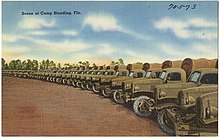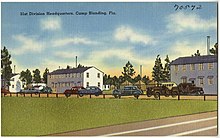Camp Blanding
Camp Blanding owes its location on the shore of Kingsley Lake to the United States Navy’s desire to establish a Naval Air Station (NAS) on the banks of the St. Johns River, south of Jacksonville, in the late 1930s. The site that would eventually become Naval Air Station Jacksonville was already the location of the Florida National Guard’s Camp Foster and negotiations were started for a land-swap. In mid-1939, the transaction was accomplished and the state armory board chose as compensation a tract of 30,000 acres (120 km2) in Clay County as a National Guard camp and training site. The National Guard Officers Association of Florida recommended the new camp be named in honor of Lieutenant General Albert H. Blanding. The War Department agreed and Camp Blanding’s history began.
Blanding graduated from the East Florida Seminary (now the University of Florida) in 1894 and entered military service. He commanded the 2nd Florida Infantry during the Mexican Border Service in 1916 and 1917.
In 1940, Camp Blanding was leased to the United States Army as an active duty training center. The post was originally used by New England and Southern troops preparing for deployment overseas. However, during the course of the war, Camp Blanding served as an infantry replacement training center, an induction center, a German prisoner-of-war compound, and a holding center for 343 Japanese, German and Italian immigrant residents of the United States. At the height of the war, the Army leased acreage from local landowners, raising the total to 170,000 acres (690 km2). From 1940 to 1945, more than 800,000 soldiers received all or part of their training here.
At one point during the war, the camp contained the population of the fourth largest city in Florida. There were 10,000 buildings, 125 miles (201 km) of paved roads, the largest hospital in the state. It was one of the largest training bases in the country.
After the war, the state’s 30,000 acres (120 km2) were returned to the armory board and by 1948, most of the buildings were sold or moved off post. In the early 1950s, the Federal Government deeded additional land to the State of Florida for use as a National Guard training facility, but until 1970, the post saw only limited use by the military.
In the 1970s, an expansion program began upgrading post facilities and in 1981, the Department of Defense redesignated Camp Blanding as a Class A military installation. The designation qualified the post for use by greater numbers of troops with more diversified training.
In 1983, the 105 mm artillery firing points were used for the first time since World War II. Tank ranges were upgraded and Tank Tables I through VI can be fired. In addition to improved facilities and ranges, a parachute drop zone and an expeditionary airfield consisting of two gravel runways capable of accommodating C-130 Hercules aircraft have expanded Camp Blanding’s training capacity. The U.S. Navy also utilizes an aerial bombing and strafing target in the southern portion of the post. Upgrading of Camp Blanding’s facilities and training areas continues to this day.
From 2001 until 2008, Camp Blanding was used by the Southeast Region of the Civil Air Patrol to host their South East Region Encampment for CAP Cadets. The Florida Wing of Civil Air Patrol continues to utilize Camp Blanding for their wing-level Summer Cadet Encampments.
Source: Wikipedia
More Information on camp Blanding can be found at
http://www.campblanding-museum.org/index.html
Recent Articles
- Browse Videos of Florida’s Historical Towns and Banks
- Florida Currency Museum Open Showcasing The William Youngerman Collection
- State of Florida Civil War Currency
- Recent Acquisitions
- Mr. and Mrs. Youngerman attend the inagural “The Value of Money” exhibit
Notes & Currency
- 18__ Fernandina $3 Obsolete Note
- 1882 $50 Jacksonville Note Charter #3869
- 1902 $10 Punta Gorda Note Charter #10512
- 1882 $5 Palatka Note Charter #3223
- 1902 $5 Key West Note Charter #7942









